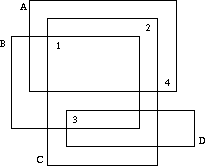Sorting Slides
Time Limit: 1000MS Memory Limit: 10000K
Total Submissions: 5070 Accepted: 1983
Description
Professor Clumsey is going to give an important talk this afternoon. Unfortunately, he is not a very tidy person and has put all his transparencies on one big heap. Before giving the talk, he has to sort the slides. Being a kind of minimalist, he wants to do this with the minimum amount of work possible.
The situation is like this. The slides all have numbers written on them according to their order in the talk. Since the slides lie on each other and are transparent, one cannot see on which slide each number is written.

Well, one cannot see on which slide a number is written, but one may deduce which numbers are written on which slides. If we label the slides which characters A, B, C, ... as in the figure above, it is obvious that D has number 3, B has number 1, C number 2 and A number 4.
Your task, should you choose to accept it, is to write a program that automates this process.
Input
The input consists of several heap descriptions. Each heap descriptions starts with a line containing a single integer n, the number of slides in the heap. The following n lines contain four integers xmin, xmax, ymin and ymax, each, the bounding coordinates of the slides. The slides will be labeled as A, B, C, ... in the order of the input.
This is followed by n lines containing two integers each, the x- and y-coordinates of the n numbers printed on the slides. The first coordinate pair will be for number 1, the next pair for 2, etc. No number will lie on a slide boundary.
The input is terminated by a heap description starting with n = 0, which should not be processed.
Output
For each heap description in the input first output its number. Then print a series of all the slides whose numbers can be uniquely determined from the input. Order the pairs by their letter identifier.
If no matchings can be determined from the input, just print the word none on a line by itself.
Output a blank line after each test case.
Sample Input
4
6 22 10 20
4 18 6 16
8 20 2 18
10 24 4 8
9 15
19 17
11 7
21 11
2
0 2 0 2
0 2 0 2
1 1
1 1
0
Sample Output
Heap 1
(A,4) (B,1) (C,2) (D,3)
Heap 2
none
题意描述:给你n张幻灯片的左上角坐标和右下角坐标,然后给出A,B,C.....等幻灯片的一个坐标,判断能否将所有幻灯片和其位置对应,如果能对应输出对应的顺序,不能则输出none。
分析:最大二分图匹配问题。关键边:是除去一条边之后图相比之前来说不连通了(其实就是最大匹配数少了)我们建图之后找出所有的关键边,再输出答案。找关键边的方法是,先删除一条边,在此情况下,最大匹配边没有少的话,他就不是关键边,同理如果少了,他就是关键边。
代码如下:
#include<stdio.h>
#include<string.h>
int a[510][510];//储存边的数组
int match[510];//匹配关系数组
int book[510];//标记数组
int n;
int xmin[510],xmax[510],ymin[510],ymax[510],x[510],y[510];
int dfs(int u)
{
int i;
for(i=1;i<=n;i++)
{
if(book[i]==0&&a[u][i]==1)//如果i未被访问且u与i匹配
{
book[i]=1;//标记点i已被访问
if(match[i]==0||dfs(match[i]))//如果点i未被配对或者找到了新的配对
{
match[i]=u;//更新配对关系
return 1;
}
}
}
return 0;
}
int connect()
{
int i;
memset(match,0,sizeof(match));
for(i=1;i<=n;i++)
{
memset(book,0,sizeof(book));//清空上次搜索时的记忆
if(dfs(i)==0)//寻找增广路,如果没有找到证明比最大匹配数少了,返回0
return 0;
}
return 1;
}
int main()
{
int i,j,t=0,flag;
while(scanf("%d",&n),n!=0)
{
t++;
for(i=1;i<=n;i++)
{
scanf("%d%d%d%d",&xmin[i],&xmax[i],&ymin[i],&ymax[i]);
}
for(i=1;i<=n;i++)
{
scanf("%d%d",&x[i],&y[i]);
}
memset(a,0,sizeof(a));//千万不要忘了数组清零哦
for(i=1;i<=n;i++)
{
for(j=1;j<=n;j++)
{
if(x[j]>=xmin[i]&&x[j]<=xmax[i]&&y[j]>=ymin[i]&&y[j]<=ymax[i])
a[i][j]=1;//读入边
}
}
printf("Heap %d\n",t);
flag=0;
for(i=1;i<=n;i++)
{
for(j=1;j<=n;j++)
{
if(a[i][j]==0)
continue;
a[i][j]=0;//先让此边消失,看影响最大匹配数不
if(connect()==0)//匹配数减少,为关键边
{
if(flag==0)//处理格式问题
{
flag=1;
printf("(%c,%d)",i-1+'A',j);
}
else
printf(" (%c,%d)",i-1+'A',j);
}
a[i][j]=1;//恢复边
}
}
if(flag==0)
printf("none");
printf("\n\n");
}
return 0;
}







 本文介绍了一种解决幻灯片排序问题的算法,通过构建最大二分图匹配模型,确定每张幻灯片在其堆叠状态下的确切位置。文章详细阐述了如何通过删除边来判断关键边,从而确定幻灯片与其位置的唯一对应关系。
本文介绍了一种解决幻灯片排序问题的算法,通过构建最大二分图匹配模型,确定每张幻灯片在其堆叠状态下的确切位置。文章详细阐述了如何通过删除边来判断关键边,从而确定幻灯片与其位置的唯一对应关系。
















 778
778

 被折叠的 条评论
为什么被折叠?
被折叠的 条评论
为什么被折叠?








